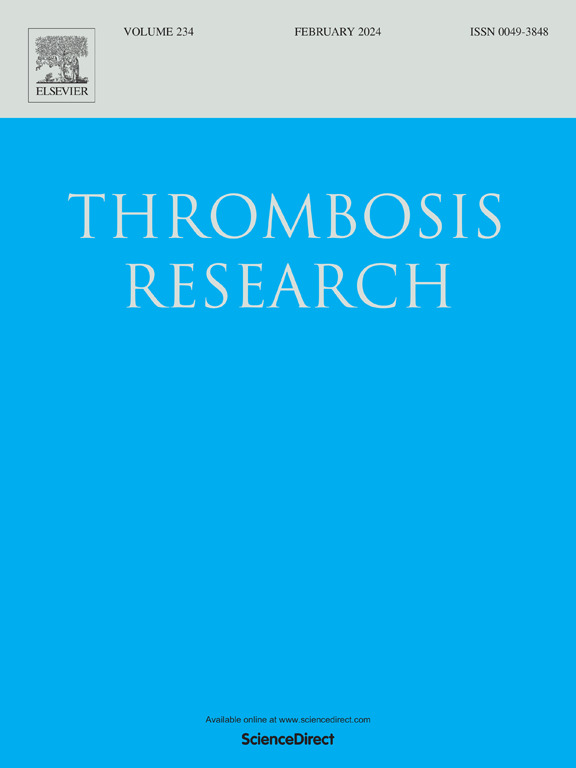与杂合型和复合杂合型出血相关的一种新的因子X变异p.F139L的特征
IF 3.4
3区 医学
Q1 HEMATOLOGY
引用次数: 0
摘要
先天性X因子缺乏症是一种罕见的出血性疾病。杂合子患者可能会在拔牙和手术后出现出血,如鼻出血或出血并发症,而纯合子患者通常会出现更严重的出血。目的:描述在两个不相关的有轻度至中度出血倾向的先证中发现的一种新的FX变异。方法检测先证及其家族的凝血酶原时间(PT) Quick、APTT、FX活性、FX抗原、凝血酶生成及DNA测序。F10变异在程序中进行了计算机预测和结构分析,并在体外表达用于进一步表征。结果在先证子1中发现新的错义变异(C . 415t >;C, p.F139L),在先证子2中发现复合杂合型错义变异(C . 424g > a, p.E142K)。所有携带p.F139L变异的个体PT Quick (11.9-15.9 s)和APTT (36-43 s)均呈临界/延长,凝血酶生成减少。FX抗原(30 - 51%)和活性(37-63 IU/dL)均降低,提示I型缺乏。结构分析表明,在p.F139L变异体中,EGF-2与FX蛋白酶结构域之间的相互作用可能被破坏,导致蛋白质不稳定。p.E142K型被预测对外汇结构的影响较小。体外表达结果进一步支持血浆研究结果。结论我们报道了一种新的FX变异,p.F139L,引起I型FX缺陷,并伴有轻度至中度出血,包括杂合型和复合杂合型。这种变异引起结构变化,可能影响FX的细胞内加工。本文章由计算机程序翻译,如有差异,请以英文原文为准。
Characterization of a novel factor X variant, p.F139L, associated with bleedings in heterozygous and compound heterozygous form
Introduction
Congenital factor X (FX) deficiency is a rare bleeding disorder. Heterozygous patients may experience bleedings like epistaxis or bleeding complications after dental extraction and surgery, whereas homozygous individuals often experience more severe bleedings.
Aim
To characterize a new FX variant found in two unrelated probands with mild to moderate bleeding tendencies.
Methods
Prothrombin time (PT) Quick, APTT, FX activity, FX antigen, thrombin generation and DNA sequencing were performed for probands and their families. F10 variants were explored in programs for in silico predictions and structural analyses, and in vitro expression was used for further characterization.
Results
A novel missense variant (c.415T>C, p.F139L) was found in heterozygous form in proband 1 and in compound heterozygous form in proband 2, in combination with a previously known missense variant (c.424G>A, p.E142K). All individuals carrying the p.F139L variant had borderline/prolonged PT Quick (11.9–15.9 s) and APTT (36–43 s) and reduced thrombin generation. Both FX antigen (30–51 %) and activity (37–63 IU/dL) were reduced, indicating a type I deficiency. Structural analysis indicated that interactions between the EGF-2 and the protease domain of FX could be disrupted in the p.F139L variant, causing destabilization of the protein. The p.E142K variant was predicted to have less impact on FX structure. In vitro expression results further supported plasma findings.
Conclusion
We report a new FX variant, p.F139L, causing a type I FX deficiency associated with mild to moderate bleedings in heterozygous and compound heterozygous form. The variant causes structural changes which likely affect intracellular processing of FX.
求助全文
通过发布文献求助,成功后即可免费获取论文全文。
去求助
来源期刊

Thrombosis research
医学-外周血管病
CiteScore
14.60
自引率
4.00%
发文量
364
审稿时长
31 days
期刊介绍:
Thrombosis Research is an international journal dedicated to the swift dissemination of new information on thrombosis, hemostasis, and vascular biology, aimed at advancing both science and clinical care. The journal publishes peer-reviewed original research, reviews, editorials, opinions, and critiques, covering both basic and clinical studies. Priority is given to research that promises novel approaches in the diagnosis, therapy, prognosis, and prevention of thrombotic and hemorrhagic diseases.
 求助内容:
求助内容: 应助结果提醒方式:
应助结果提醒方式:


